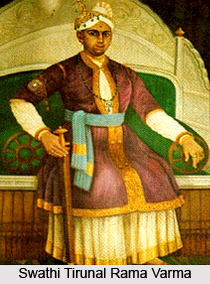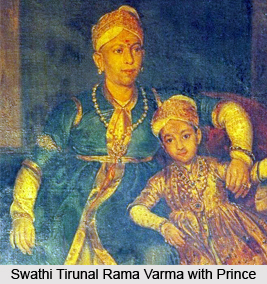 Swathi Tirunal Rama Varma was an Indian classical singer born on 16th April, 1813 in the Travancore city of Kerala. He belonged to a royal family and that was evident by the way he conducted himself, and through his extraordinary and phenomenal musical performances. He was a combination of royalty and talent, which is not often found in Indian musical arena. Maharajah Swathi Tirunal Rama Varma made sure that he not only fell into this category, but also gained popularity in the field of classical music set up.
Swathi Tirunal Rama Varma was an Indian classical singer born on 16th April, 1813 in the Travancore city of Kerala. He belonged to a royal family and that was evident by the way he conducted himself, and through his extraordinary and phenomenal musical performances. He was a combination of royalty and talent, which is not often found in Indian musical arena. Maharajah Swathi Tirunal Rama Varma made sure that he not only fell into this category, but also gained popularity in the field of classical music set up.
He made over 400 compositions in five various languages like Sanskrit, Malayalam, Hindustani, Telugu, and Kannada. He created music in numerous types like Tanavarnam, Padavarnam, Swarajati, Krti, Kirtanam, Ragamalika, Javali, Tillana, Bhajan, and even some Hindusthani styles, such as Drupad and Tappa.
Early Life of Swathi Tirunal Rama Varma
Swathi Tirunal Rama Varma took birth in the princely state of South India, Travancore. He was the second child to Regent Queen Gowri Lakshmi Bayi and Rajaraja Varma Koyithampuran of Changanasseri Palace. He had a younger brother and elder sister by the name of Uthram Thirunal Marthanda Varma and Rukmini Bai respectively. His mother died after the birth of the third child. And during that time Rama Varma was just 17 months old, as a result he was brought up by his mother`s sister, Gowri Parvati Bayi. He remained with his aunt until he became old enough to take care of himself. And at the age of 14 Ram Varma ascended the throne and took over as king.
As his father and aunt were both scholar and learned person, so the entire education of Rama Varma was carefully taken care of. He began learning Malayalam and Sanskrit when he was six and English at seven. By the time he grew up as an adult he was proficient in several languages like Malayalam, Tamil, Kannada, Hindustani, Telugu, Marathi, English, Persian, and Sanskrit. Rama Varma took keen interest in poetry, grammar and drama, apart from language.

Career of Swathi Tirunal Rama Varma
Swati Tirunal was inspired into classical music by an eminent musician of the palace, Karamana Subrahmanya Bhagavatar. Subba Rao did not possess any academic knowledge about music, but was quite proficient in its practical applicability. He got involved with music and singing and began to enjoy it to the fullest. He was learnt how to play swarabat, a musical instrument. His love for music brought him close to number of musicians to the court, who in turn gave Swati a precious inner view into the field of Indian classical music. Meruswamy alias Anantapadmanabha Goswami, a Maratha singer, gave Rama Varma an introduction to Hindusthani music and Carnatic Music. He also helped him get proper understanding of `harikatha` tradition. Some musicians and scholars who worked in close quarters with Rama Varma include Irayimman Thampi (poet), Shatkala Govinda Marar (musician), Parameswara Bhagavatar (singer), Kilimannoor Koil (Sanskrit scholar cum poet).
Contribution of Swathi Tirunal Rama Varma to Music
Swathi Tirunal Rama Varma made immense contribution to Indian music. He composed nearly 500 songs, which is loved, admired and appreciated even today. He even composed musical plays as well. Some of his memorable works include Varnams, Javalis, Padams, Swarajatis, Kritis, and many more. Some of his praiseworthy work, as per Hindustani music is concerned is Dhrupads, Thumris, Tappas, Bhajans, Khyal, etc. For the Navaratri festivity, he composed numerous kritis in the praise of Goddess Devi.
Personal Life of Swathi Tirunal Rama Varma
Swathi Tirunal Rama Varma to Music married early in his life, but his wife died at a very young age. He married a second time to Thiruvattar Ammachi Panapillai Amma Srimathi Narayani Pillai Kochamma of the Thiruvattar Ammaveedu family. His second wife was a trained Veena player and Carnatic singer. They had a son together named Thiruvattar Chithira Nal Anantha Padmanabhan Chempakaraman Thampi. Swathi Thirunal, in 1843, married for the third time to Sundara Lakshmi Ammal, daughter of a Mudaliar, who migrated to Trivandrum. Sundara was popularly called Sugandhavalli, as she was a dancer. Legend has it that his second wife did not approve the marriage and hence, Sugandhavalli was thrown out from Travancore. This proved traumatic for the Maharajah was believed to have died due to broken heart in 1846.
This great benefactor of music and art left for the heavenly abode in the year 1846, at an early age of 33, leaving behind his followers and disciples in suffering and distress. After his death, Uthram Thirunal Marthanda Varma, his elder brother, succeeded the throne and retained it until his death in 1860. Thereafter, his nephew and nice ascended the throne and ruled the kingdom of Travancore.




